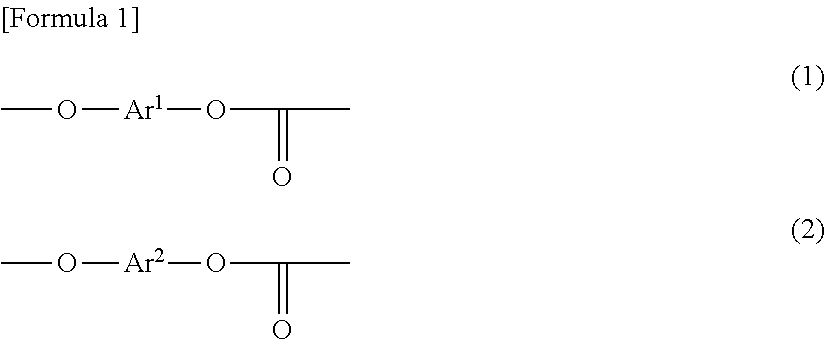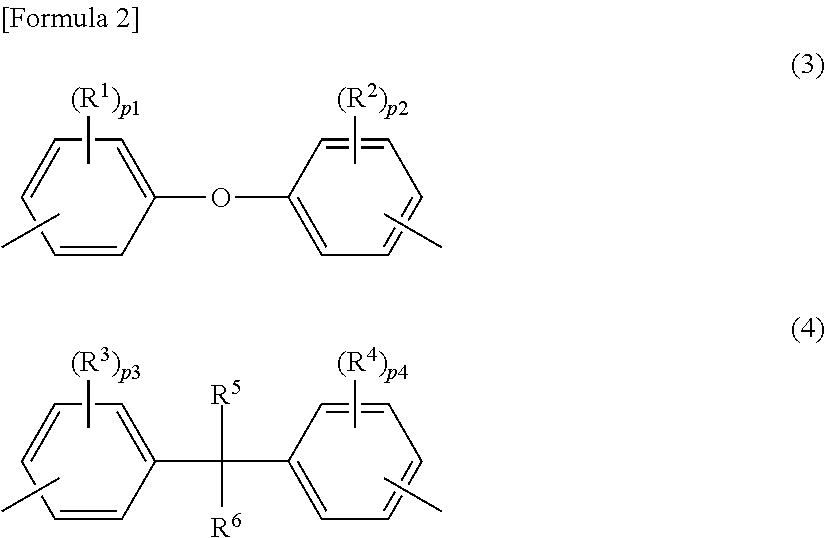Polycarbonate copolymer, coating liquid using same, and electrophotographic photoreceptor
a technology of polycarbonate copolymer and coating liquid, which is applied in the direction of electrographic process, instruments, corona discharge, etc., can solve the problem of insufficient durability of polycarbonate resin, and achieve the effect of reducing residual potential, reducing fatigue, and enhancing sensitivity
- Summary
- Abstract
- Description
- Claims
- Application Information
AI Technical Summary
Benefits of technology
Problems solved by technology
Method used
Image
Examples
manufacturing example 1
Synthesis of DHPE Oligomer (Bischloroformate)
[0156]45.2 kg (224 mol) of 4,4-dihydroxydiphenylether (DHPE) was suspended in 1080 L of methylene chloride, to which 66.0 kg (667 mol) of phosgene was added and dissolved. Into this obtained solution, a solution in which 44.0 kg (435 mol) of triethylamine was dissolved in 120 L of methylene chloride was dropped at 2.2 to 17.8 degrees C. for 2 hours and 50 minutes. After the solution was stirred at 17.9 to 19.6 degrees C. for 30 minutes, 900 L of methylene chloride was distilled away at 14 to 22 degrees C. 210 L of deionized water, 1.2 kg of concentrated hydrochloric acid and 450 g of hydrosulphite were added to the residual solution for cleaning. Subsequently, cleaning with 210 L of deionized water was repeated five times. A methylene chloride solution of a DHPE oligomer having a chloroformate group at its molecular terminal was obtained. The obtained solution had a chloroformate concentration of 1.14 mol / L, a solid concentration of 0.19 ...
manufacturing example 2
Synthesis of Bisphenol B Oligomer (Bischloroformate)
[0158]Into a mixed solution containing 210 g (0.867 mol) of 2,2-bis(4-hydroxyphenyl)butane (bisphenol B), 1058 mL of methylene chloride and 183 g (1.85 mol) of phosgene, a solution prepared by diluting 200.8 g (1.98 mol) of triethylamine in 460 mL of methylene chloride was dropped at 14 to 18.5 degrees C. for 2 hours and 50 minutes. After the reactant mixture was stirred at 18.5 to 19 degrees C. for one hour, 600 ml of methylene chloride was distilled away at 10 to 22 degrees C. 15.0 mL of concentrated hydrochloric acid, 150 mL of deionized water and 0.100 g of hydrosulphite were added to the reactant mixture for cleaning. Subsequently, cleaning with water was repeated until an aqueous phase becomes neutral. Thus, a methylene chloride solution of a bisphenol B oligomer having a chloroformate group at its molecular terminal was obtained.
[0159]The same operation as in Manufacturing Example 1 was conducted except that a diluted soluti...
manufacturing example 3
Synthesis of Bisphenol E Oligomer (Bischloroformate)
[0161]Into a mixed solution containing 73.0 g (0.341 mol) of 1,1-bis(4-hydroxyphenyl)ethane (bisphenol E), 410 mL of methylene chloride and 65 g (0.689 mol) of phosgene, a solution prepared by diluting 68.7 g (0.682 mol) of triethylamine in 245 mL of methylene chloride was dropped at 14 to 18.5 degrees C. for 2 hours and 50 minutes. After the reactant mixture was stirred at 18.5 to 19 degrees C. for one hour, 250 mL of methylene chloride was distilled away at 10 to 22 degrees C. 5.0 mL of concentrated hydrochloric acid, 73 mL of deionized water and 0.47 g of hydrosulphite were added to the reactant mixture for cleaning. Subsequently, cleaning with water was repeated until an aqueous phase becomes neutral. Thus, a methylene chloride solution of a bisphenol E oligomer having a chloroformate group at its molecular terminal was obtained.
[0162]The obtained solution had a chloroformate concentration of 1.31 mol / L, a solid concentration o...
PUM
| Property | Measurement | Unit |
|---|---|---|
| Electrical conductor | aaaaa | aaaaa |
| Photosensitivity | aaaaa | aaaaa |
Abstract
Description
Claims
Application Information
 Login to View More
Login to View More - R&D
- Intellectual Property
- Life Sciences
- Materials
- Tech Scout
- Unparalleled Data Quality
- Higher Quality Content
- 60% Fewer Hallucinations
Browse by: Latest US Patents, China's latest patents, Technical Efficacy Thesaurus, Application Domain, Technology Topic, Popular Technical Reports.
© 2025 PatSnap. All rights reserved.Legal|Privacy policy|Modern Slavery Act Transparency Statement|Sitemap|About US| Contact US: help@patsnap.com



